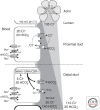Transepithelial bicarbonate secretion: lessons from the pancreas
- PMID: 23028131
- PMCID: PMC3475396
- DOI: 10.1101/cshperspect.a009571
Transepithelial bicarbonate secretion: lessons from the pancreas
Abstract
Many cystic fibrosis transmembrane conductance regulator (CFTR)-expressing epithelia secrete bicarbonate (HCO(3)(-))-containing fluids. Recent evidence suggests that defects in epithelial bicarbonate secretion are directly involved in the pathogenesis of cystic fibrosis, in particular by building up hyperviscous mucus in the ductal structures of the lung and pancreas. Pancreatic juice is one of the representative fluids that contain a very high concentration of bicarbonate among bodily fluids that are secreted from CFTR-expressing epithelia. We introduce up-to-date knowledge on the basic principles of transepithelial bicarbonate transport by showing the mechanisms involved in pancreatic bicarbonate secretion. The model of pancreatic bicarbonate secretion described herein may also apply to other exocrine epithelia. As a central regulator of bicarbonate transport at the apical membrane, CFTR plays an essential role in both direct and indirect bicarbonate secretion. The major role of CFTR in bicarbonate secretion would be variable depending on the tissue and cell type. For example, in epithelial cells that produce a low concentration of bicarbonate-containing fluid (up to 80 mm), either CFTR-dependent Cl(-)/HCO(3)(-) exchange or CFTR anion channel with low bicarbonate permeability would be sufficient to generate such fluid. However, in cells that secrete high-bicarbonate-containing fluids, a highly selective CFTR bicarbonate channel activity is required. Therefore, understanding the molecular mechanism of transepithelial bicarbonate transport and the role of CFTR in each specific epithelium will provide therapeutic strategies to recover from epithelial defects induced by hyposecretion of bicarbonate in cystic fibrosis.
Figures



Similar articles
-
Development of a polarized pancreatic ductular cell epithelium for physiological studies.J Appl Physiol (1985). 2018 Jul 1;125(1):97-106. doi: 10.1152/japplphysiol.00043.2018. Epub 2018 Mar 8. J Appl Physiol (1985). 2018. PMID: 29517421 Free PMC article.
-
Physiology and pathophysiology of bicarbonate secretion by pancreatic duct epithelium.Nagoya J Med Sci. 2012 Feb;74(1-2):1-18. Nagoya J Med Sci. 2012. PMID: 22515107 Free PMC article. Review.
-
Novel role for pendrin in orchestrating bicarbonate secretion in cystic fibrosis transmembrane conductance regulator (CFTR)-expressing airway serous cells.J Biol Chem. 2011 Nov 25;286(47):41069-82. doi: 10.1074/jbc.M111.266734. Epub 2011 Sep 13. J Biol Chem. 2011. PMID: 21914796 Free PMC article.
-
Bicarbonate Transport in Cystic Fibrosis and Pancreatitis.Cells. 2021 Dec 24;11(1):54. doi: 10.3390/cells11010054. Cells. 2021. PMID: 35011616 Free PMC article. Review.
-
Ca2+ activates cystic fibrosis transmembrane conductance regulator- and Cl- -dependent HCO3 transport in pancreatic duct cells.J Biol Chem. 2003 Jan 3;278(1):200-7. doi: 10.1074/jbc.M207199200. Epub 2002 Oct 29. J Biol Chem. 2003. PMID: 12409301
Cited by
-
A long journey to the colon: The role of the small intestine microbiota in intestinal disease.Mol Microbiol. 2024 Sep;122(3):304-312. doi: 10.1111/mmi.15270. Epub 2024 May 1. Mol Microbiol. 2024. PMID: 38690771 Free PMC article. Review.
-
CFTR Modulators Counteract F508del CFTR Functional Defects in a Pancreatic Epithelial Model of Cystic Fibrosis.Life (Basel). 2025 Aug 19;15(8):1315. doi: 10.3390/life15081315. Life (Basel). 2025. PMID: 40868962 Free PMC article.
-
New paradigms on the transport functions of maturation-stage ameloblasts.J Dent Res. 2013 Feb;92(2):122-9. doi: 10.1177/0022034512470954. Epub 2012 Dec 14. J Dent Res. 2013. PMID: 23242231 Free PMC article. Review.
-
The cystic fibrosis intestine.Cold Spring Harb Perspect Med. 2013 Sep 1;3(9):a009753. doi: 10.1101/cshperspect.a009753. Cold Spring Harb Perspect Med. 2013. PMID: 23788646 Free PMC article. Review.
-
Regulation of CFTR Bicarbonate Channel Activity by WNK1: Implications for Pancreatitis and CFTR-Related Disorders.Cell Mol Gastroenterol Hepatol. 2020;9(1):79-103. doi: 10.1016/j.jcmgh.2019.09.003. Epub 2019 Sep 24. Cell Mol Gastroenterol Hepatol. 2020. PMID: 31561038 Free PMC article.
References
-
- Abuladze N, Lee I, Newman D, Hwang J, Boorer K, Pushkin A, Kurtz I 1998. Molecular cloning, chromosomal localization, tissue distribution, and functional expression of the human pancreatic sodium bicarbonate cotransporter. J Biol Chem 273: 17689–17695 - PubMed
-
- Ahn W, Kim KH, Lee JA, Kim JY, Choi JY, Moe OW, Milgram SL, Muallem S, Lee MG 2001. Regulatory interaction between the cystic fibrosis transmembrane conductance regulator and HCO3− salvage mechanisms in model systems and the mouse pancreatic duct. J Biol Chem 276: 17236–17243 - PubMed
-
- Argent B, Case R 1994. Pancreatic ducts. Cellular mechanism and control of bicarbonate secretion. In Physiology of the gastrointestinal tract (ed. Johnson LR), pp. 1473–1497 Raven, New York
-
- Begenisich T, Nakamoto T, Ovitt CE, Nehrke K, Brugnara C, Alper SL, Melvin JE 2004. Physiological roles of the intermediate conductance, Ca2+-activated potassium channel Kcnn4. J Biol Chem 279: 47681–47687 - PubMed
Publication types
MeSH terms
Substances
LinkOut - more resources
Full Text Sources
Medical
Research Materials
